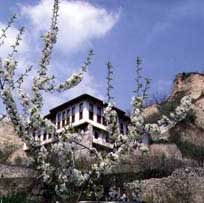|
|
| |
BULGARIA
MELNIK
In the Southwest of the Pirin Mountain stand the Melnik Pyramids - sheer, strangely shaped sand and limestone rocks. And here amongst this breathtaking scenery you will find Melnik, one of Bulgaria's smallest towns. Hidden by a seemingly impenetrable mountain wall, the village was able to withstand the effects of the Byzantine Empire in the 11th century. And yet once there, you find yourself in an attractive main square with taverns and timber propped whitewashed stone houses leading off to cobbled streets and courtyards where flowers and vines adorn the facades.
 Melnik is an old wine center. Melnik wine was highly appreciated at the market of Thessalonica. The town has been popular as a wine-growing region since l346. The famous Melnik vine had been brought here from Syria in ancient times. During the first half of XIII century Melnik passed through a great political, economic and cultural upsurge, when despot Slav, a descendent of Assen dynasty ruler of the Rhodopes and Pirin mountain during 1209 turned the town into a capital of an independent feudal principality. Building developed to a great extent. Most of the house-building ruins are of that time. According to archaeological investigations data, residential quarters existed not only at the hill of St. Nicholas - the main center of mediaeval Melnik, but also at its foot in the North. Much representative was the Boyars House whose ruins may be observed at Chatala height in the Eastern part of the town.
|
|
|
Festivals and Fairs
The Great Koprivshtitza Folklore Festival
The Great Koprivshtitza Folklore Festival is Bulgaria's largest gathering of traditional musicians and singers and is a cross between a pop festival and a medieval fair. It is a sight that knows no equal: thousands of musicians and singers making the hillside above the picturesque village of Koprivshtitza their home for a few days. Coupled with this you have the colourful stalls of the traders and the thousands of visitors who come for the festival.
This is Bulgarian music as it was always played, played by the ancestors of those who first played it. But perhaps it is what happens on the periphery that is the most authentic. Strolling players or soloists, simply playing for the sheer enjoyment. forming new bonds with other musicians or just letting their music ring out over the hillside.
The Bourgas International Folk Festival
The Bourgas International Folk Festival, held annually, attracts a host of Bulgarian and international artists and is held in the second half of August.
The Kazanluk Festival
The Kazanluk Festival of the Roses is held annually in early June, and has grown from a local to an international event. Not only are the roses, Kazanluk's main industry, in full flower. but the town itself blossoms while visitors enjoy the "Rose Picnic" and all the fun of a folklore festival, with its costumes, songs and dance. Should you still have the energy left, you can always visit the old factories where the rose oil is extracted.
St. Trifon's Day
In the agricultural calendar, St. Trifon's Day celebrates the pruning of the vines, and is held on February 14.
Kukerov Den
On the first Sunday before Lent, Kukerov Den celebrates the start of the agricultural year, and all over Bulgaria you can witness processions led by the dancing. leaping Kukeri dressed in colourful masks and costumes.
Baba Marta
Baba Marta is celebrated on March 1 when peasant house-holds brush out the winter cobwebs with a traditional spring clean. and people offer each other tokens of good luck called martenitsas.
Kukeri
Like western countries. the Bulgarian calendar is dotted with important feast days and festivals. The festival of the Kukeri re-enacts ancient surovaki rites to ward off evil spirits and Kukeri fertility rites. Although only held once every five years, it brings together dancers from all over Bulgaria in a rainbow of colours and styles.
St. Lazarus Day
Lazaruvane is also celebrated in spring on St. Lazarus Day, and here village girls considered fit for marriage perform ritual songs and dances.
St. Konstantin and St. Elena Day
The coming of summer is traditionally celebrated on St. Konstantin and St. Elena Day on May 21, and in some of the remoter villages in the Stranzha hills fire dancing, dancing on heated coals, is still practised in celebration of summer's arrival. Ethnologists have suggested that this practice is directly descended from Dionysina rites of the ancient Thracian.
|